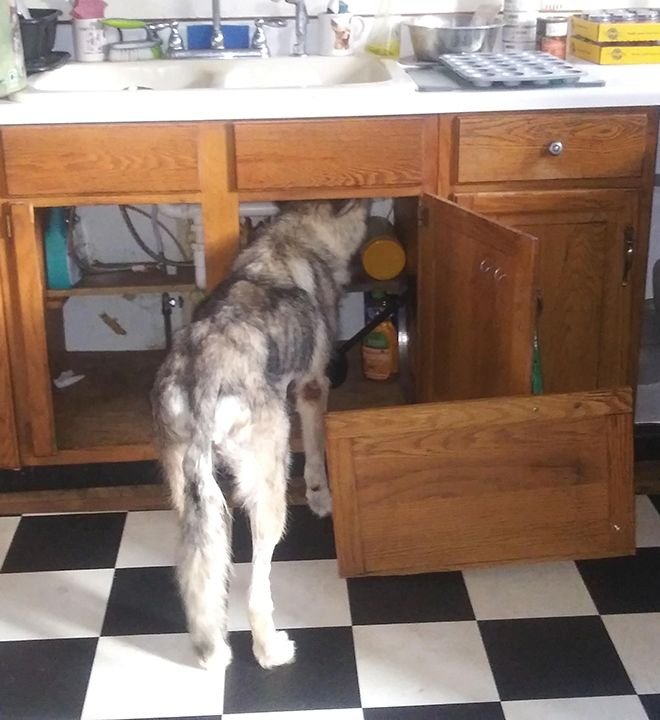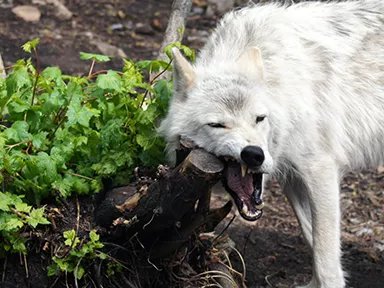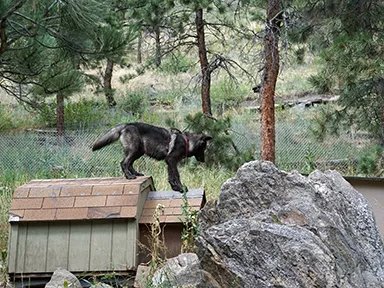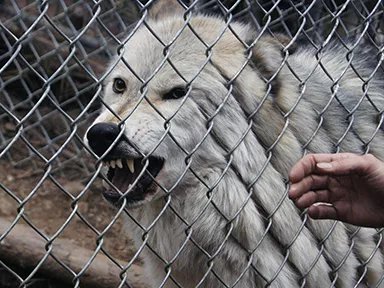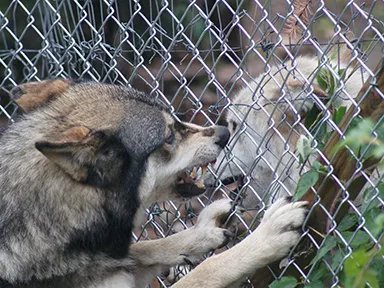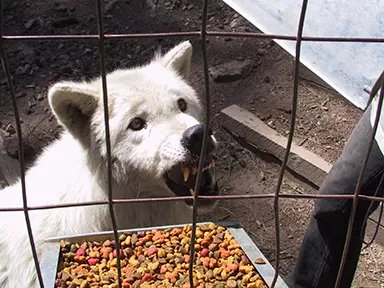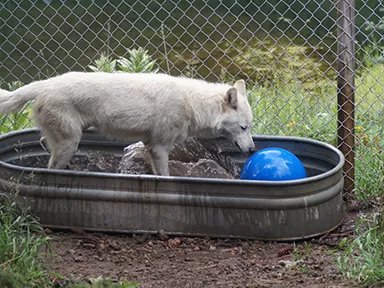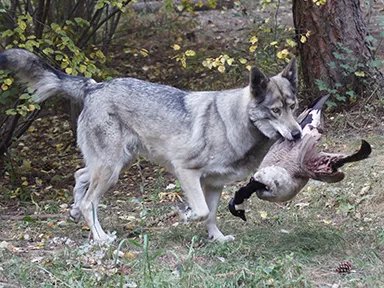Although W.O.L.F. does not support the breeding of wolf dogs, we understand that many wolf dogs will end up in shelters and euthanized by the age of two years old because of indiscriminate breeding. W.O.L.F understands that owning a wolf dog can present many challenges that can be overwhelming for unprepared and uneducated owners. To help combat the euthanasia of so many young wolf dogs, W.O.L.F. has compiled information and resources to help wolf dog owners of wolf dogs properly care for their animals.
ENCLOSURES
Wolf dogs are intelligent, energetic, curious and easily bored. When wolf dogs get bored, they may become destructive and/or escape artists. It is essential for owners to have appropriate containment. An enclosure must be well built and meet two important criteria:
- have enough space and enrichment to keep the wolf dog feeling safe and entertained and
- be secure and escape proof and
- meet federal, state, and local permitting and other requirements
The enclosure should include areas for shade, water, and provide shelter from the elements (rain, snow, wind, etc.) and be cleaned regularly. There should be items to entertain the wolf dog such as boulders, trees and bushes, pools, and chew-safe toys. An engaged and happy wolf dog who is challenged by the environment will be less likely to try to escape their containment.
ADDITIONAL DESIGN SUGGESTIONS
It is also recommended that the enclosure is in an area that allows the wolf dog the freedom to “landscape” the habitat. Wolf dogs enjoy digging dens, burying food and toys, chewing on bushes and trees, and rolling and playing in the dirt and grass. Wolf dogs should not be kept in an area that must be kept nicely landscaped. That will lead to frustration between the owner and the wolf dog.
Be aware of where the fences are in relation to other objects in the habitat (i.e. rocks, dog houses, play structures, etc.) If these items are too close to the fence, animals may be able to utilize them as a spring-board to jump or climb out.
DIET
Wolves are carnivores while dogs are omnivores, which means they have different dietary requirements and tolerances. Wolves in the wild consume raw meat, organs, hide and bones with only a minimal amount of vegetation. As a result, they have evolved a digestive system that specializes in digesting and extracting nutrients from a high-protein diet and do poorly when only fed commercial pet food diets. Dogs, on the other hand, have a much less specialized digestive system and are capable of successfully extracting nutrients from both meat and vegetation they consume. Wolf dogs, being both, can land anywhere in between these two systems. As a result, it is recommended that a wolf dog’s diet include raw meat as well as high-quality dog kibble or nutrient supplements. It is not recommended that wolves or wolf dogs be given a meat only diet unless they are regularly fed organ meat, bones, hides or have their meals supplemented with nutritional supplements. This is because muscle meat lacks many of the vitamins and minerals necessary for the animal to be healthy.
The amount of meat and kibble fed daily depends on the dietary needs of each individual based on age, size, health, the type and quality of nutritional supplements being given and should always be discussed with a veterinarian. At W.O.L.F., each wolf dog averages about two pounds of raw meat and 1.5 cups of kibble a day.
 The right time to spay or neuter a dog is a challenging question, and many factors should be considered when making this decision. Some advocates suggest spaying and neutering at a young age to prevent pet overpopulation. Others argue for it to occur later in the animal’s life, or not at all. Recent evidence suggests that the expected adult size of the dog is likely a key factor in determining the best age for spaying/neutering to minimize health complications like joint or bone diseases later in life. These studies suggest that large breed dogs (weighing 66 lbs – 87 lbs) should be spayed or neutered after the age of 12 months. Giant breeds (weighing 88+ lbs) should be spayed or neutered after the age of 24 months. Some research suggests that waiting until after the animal reaches sexual maturity may help to reduce the risks of joint issues. Alternatively, there is also evidence to suggest that waiting for sexual maturity could result in possible increased risks for prostate or mammary cancers. It is always best to consult with a licensed veterinarian to determine the appropriate age for spay/neuter.
The right time to spay or neuter a dog is a challenging question, and many factors should be considered when making this decision. Some advocates suggest spaying and neutering at a young age to prevent pet overpopulation. Others argue for it to occur later in the animal’s life, or not at all. Recent evidence suggests that the expected adult size of the dog is likely a key factor in determining the best age for spaying/neutering to minimize health complications like joint or bone diseases later in life. These studies suggest that large breed dogs (weighing 66 lbs – 87 lbs) should be spayed or neutered after the age of 12 months. Giant breeds (weighing 88+ lbs) should be spayed or neutered after the age of 24 months. Some research suggests that waiting until after the animal reaches sexual maturity may help to reduce the risks of joint issues. Alternatively, there is also evidence to suggest that waiting for sexual maturity could result in possible increased risks for prostate or mammary cancers. It is always best to consult with a licensed veterinarian to determine the appropriate age for spay/neuter.
Wolves mature sexually at around two years old, much later than most domestic dogs who often reach sexual maturity between six to nine months. This means that it can be difficult to predict when a wolf dog will reach sexual maturity, though in general, high content wolf dogs are more likely to follow the wolf reproductive strategy and mature later than mid to low content individuals. Additionally, wolves (and many wolf dogs) are only able to breed once a year, whereas dogs breed twice a year on average. As a result, there are often significant behavioral changes in wolves and wolf dogs during breeding season (see the section below for more information).
Spaying and neutering may help mitigate some of the more extreme behavior changes, especially if done before an animal reaches sexual maturity. However, it will not “cure” a wolf dog of challenging or unwanted behaviors. If an owner chooses to wait to spay/neuter, it is important they pay attention to signs that the animal may be reproductively viable and take the necessary steps to prevent issues or unwanted litters.
Wolf dogs may go through behavioral changes during the winter that confuse or frustrate owners, and often result in an animal being surrendered or euthanized because of owner ignorance. This seasonal behavioral change is common among higher content wolf dogs and is often referred to as Winter Wolf Syndrome. Winter Wolf Syndrome is caused by changes in hormones associated with the natural reproductive cycle of a wolf. Unlike dogs, both male and female wolves are reproductively viable only once a year, from January to March depending on the individual’s location and latitude. As a result, both males and females may experience major fluctuations in hormone concentrations throughout the year. For males, testosterone levels are extremely low from June through September then peak between December and March. Females also experience prolonged peaks and valleys in the concentration of their reproductive hormones throughout the year. In the late fall and winter, these hormone shifts initiate wolf courtship behaviors.
Many wolf dogs, especially high content wolf dogs, follow similar reproductive patterns to wolves and should be expected to experience these hormonal behavior changes, though the degree to which they will be expressed (ranging from mild grumpiness to extreme aggression) varies between individuals. Some commonly observed changes include: increased aggression (especially between same-sex individuals), increased possessiveness or guarding behaviors, increased willfulness with a disinterest in obeying commands, increased aloofness and/or heightened prey drive. While any or all of these behaviors can be observed in both sexes, males generally display more territorial and defensive behaviors while females often experience increased same-sex aggression and can cause serious harm to each other if housed together. However, some females may become more affectionate or clingy with those to whom they are strongly bonded during this time.
Winter Wolf Syndrome is most commonly experienced in pure wolves or high-content wolf dogs. However, it is important to remember that any wolf dog has the potential to experience it. Owners must also recognize that this is NOT something that can be trained out of an animal. It is part of the reality and responsibility of wolf dog ownership. Although spaying and neutering may help lessen some of the symptoms of Winter Wolf Syndrome, it may not eliminate them completely.
The first step to managing Winter Wolf Syndrome is to recognize it is natural and usually seasonal. It is important for owners to remain vigilant around wolf dogs and pay close attention to their body language. Owners need to develop strategies that allow them to safely care for the wolf dog without putting humans or the animals at risk. Some solutions may include: not entering an enclosure alone, setting up the habitat to allow for all necessary care (feeding, watering, cleaning) to be done without direct contact with the wolf dogs, and not housing intact or same-sex individuals together during breeding season.
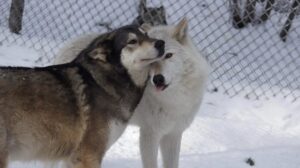 Wolf dogs are highly social animals, and in most cases human companionship alone is not enough to satisfy a wolf dog’s companionship requirements. Therefore, it is critical that the wolf dog has an acceptable canine companion. The companion does not have to be a wolf dog, but it should be a dog roughly the same size, close in age, and ideally the opposite sex of the wolf dog (both animals should be spayed/neutered). An owner must make sure that the animals get along with each other, and that they are safe to be left alone with one another. However, wolf dogs can be territorial, and it is best to keep social groups to a maximum of two or three animals. Keeping captive wolf dogs in packs of four or more frequently leads to fighting within the group and can result in serious injuries or death to the wolf dogs.
Wolf dogs are highly social animals, and in most cases human companionship alone is not enough to satisfy a wolf dog’s companionship requirements. Therefore, it is critical that the wolf dog has an acceptable canine companion. The companion does not have to be a wolf dog, but it should be a dog roughly the same size, close in age, and ideally the opposite sex of the wolf dog (both animals should be spayed/neutered). An owner must make sure that the animals get along with each other, and that they are safe to be left alone with one another. However, wolf dogs can be territorial, and it is best to keep social groups to a maximum of two or three animals. Keeping captive wolf dogs in packs of four or more frequently leads to fighting within the group and can result in serious injuries or death to the wolf dogs.
Wolf dogs need a lot of mental and physical stimulation. There are multiple things that can and should be done to help a wolf dog stay sharp and engaged.

Food Enrichment
A great way to enrich a wolf dog is through food, especially if the animal is food motivated. There are many great ways to do this for wolf dogs including: bones, kongs filled with peanut butter or other sticky foods, meat frozen into ice blocks, and hiding food around the enclosure for them to find.
Scent Enrichment
All canines have a strong sense of smell, and it is one of the major ways that they interact with the world. Scent enrichment can be a great way to engage a wolf dog. It may be effective to spray something smelly, like deer urine, essential oils or perfume, in the enclosure. ASPCAPRO has great resources for scent enrichment for canines (https://www.aspcapro.org/resource/scent-games-canine-enrichment).
Exercise
Exercising a wolf dog keeps them physically and mentally engaged, but can also be a good bonding time.
Activities
Doing activities with a wolf dog also help to keep them physically and mentally engaged.
Novel Items: Providing them with safe items that they do not have the opportunity to encounter regularly is also a good way to stimulate them mentally and provide them with another acceptable energy outlet. These can be items like pumpkins or watermelons, animal pelts, boxes and changing up their environment.
Puzzles: Puzzles are a great way to entertain wolf dogs by keeping their minds active and challenged. Usually this is done in tandem with food enrichment. There are many commercially available treat puzzles, however many of these puzzles may not withstand a wolf dog’s powerful jaws. Some alternatives include hiding their food around their enclosure, or putting a treat inside a cardboard box (or two) and let them tear it apart to find the treat.
Human Interaction
Socialization with people, both the owner and others, can be very enriching for a wolf dog. However, it is important to remember that each wolf dog has its own unique interaction tolerance level. It is important for an owner to know what that tolerance is for each individual and remove them from any situation where that threshold is being neared. If a wolf dog is not comfortable around other people, DO NOT introduce them to that situation. It is ideal that a wolf dog gets interaction with people (the owner and/or others) daily. It can be in the form of belly rubs, grooming, playing fetch, or just being around the animal.
Training is a great way to mentally stimulate your wolf dog, and help with bonding. It may also help an owner manage unwanted or problematic behaviors. Training a wolf dog should always use ONLY positive reinforcement — the animal receives something good (like a treat or pets) for the desired behavior. A good resource for learning how to use positive reinforcement training techniques is Don’t Shoot the Dog by Karen Pryor or visiting her website.
Training is most effective if it is done multiple times a day for five to ten minutes per session. There are many techniques that can be used to train a wolf-dog including clicker training. Wolfdog A-Z by Nicole Wilde is a good resource for wolf dog specific, positive reinforcement training suggestions, especially when dealing with behavioral issues.
ADDITIONAL RESOURCES FOR OWNING WOLF DOGS
Rick McIntyre – With decades of fieldwork and thousands of hours spent in the presence of wolves, Rick brings the wolves of Yellowstone’s stories to life with heart, detail, and reverence; plus, he’s got a great children’s book! https://www.rickmcintyre.com/books
Douglas W. Smith – As a leading wildlife biologist, Doug’s research has shaped our understanding of wolf ecology, behavior, and the vital role wolves play in healthy ecosystems. His work brought wolves back to the West and inspired generations to see the value of wild places and the creatures that call them home. https://www.goodreads.com/author/list/165182.Douglas_W_Smith
Norm Bishop – A key voice in the Yellowstone wolf reintroduction effort, Norm has dedicated his career to ensuring decisions about wildlife are rooted in research, respect for nature, and ecological balance. https://www.thewildlifenews.com/author/norman-bishop
Rick Lamplugh – A passionate voice for wildlife and wild lands, Rick Lamplugh brings readers deep into the heart of Yellowstone and beyond through personal storytelling and sharp insight. With a thoughtful, poetic style, Lamplugh’s work inspires deeper reflection on nature, aging, and our place within the wild. https://www.amazon.com/stores/author/B001H6S990
Nate Blakeslee – “American Wolf” is a gripping, beautifully written account of one of Yellowstone’s most famous wolves, O-Six. With a journalist’s eye and a storyteller’s heart, Blakeslee weaves together science, politics, and personal narratives to explore the triumphs and challenges of wolf recovery. https://www.penguinrandomhouse.com/books/248840/american-wolf-by-nate-blakeslee/
Websites:
https://betterpet.com/dog-body-language/
https://clickertraining.com/
https://www.nicolewilde.com/
http://thedarkforestgroup.com/Wolfdogs.html
https://wolf.org/wolf-info/basic-wolf-info/wolves-and-humans/wolf-dog-hybrids/
https://www.indigomountain.org/seasonal-behavior-changes
http://www.floridalupine.org/newsletters/NewsletterFall2010.pdf
https://southernohiowolfsanctuary.com/wolfdogs-hybrid-wolves/winter-wolf-syndrome-wws-grumpiness/
https://www.frontiersin.org/articles/10.3389/fvets.2020.00472/full
https://www.frontiersin.org/articles/10.3389/fvets.2020.00388/full
https://www.sciencedaily.com/releases/2020/08/200813162809.htm
https://www.theatlantic.com/science/archive/2019/07/dog-neutering-health-risks-for-certain-breeds/594355/
https://www.veterinarypracticenews.com/neutering-april-2020/
https://www.akcchf.org/educational-resources/library/articles/what-is-the-best-age-to.html
Books:
Living with Wolfdogs by Nicole Wilde
Wolfdog A-Z by Nicole Wilde
Between Dog and Wolf by Jessica Addams and Andrew Miller
Don’t Shoot the Dog by Karen Pryor (Positive reinforcement techniques)
The Hidden Lives of Wolves by Jim and Jamie Dutcher
American Wolf, A Ture Story of Survival and Obsession in the West by Nate Blakeslee
The Rise of Wolf 8 by Rick McIntyre


